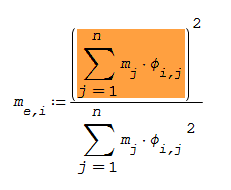Modal Mass
Each multi-mass system can usually be represented by a single-mass system. When performing this transformation, the modal mass of the system is necessary. This mass is required to generate the frequency of the equivalent single-mass oscillator.
Participation Factor
This factor can also be negative, because it consists of the equivalent mass on a node and the corresponding displacement due to the mode shape. If the deflection is in the negative direction, the participation factor becomes negative. However, the equivalent mass factor is still positive because the participation factor is squared (see the formula).
Equivalent Mass
The equivalent mass of a structural system is a part of the total mass that is excited due to the vibration of the multi-mass oscillator. The equivalent mass of a structural system can be between zero and the total mass. The equivalent mass factor is only the quotient from the total mass to the equivalent mass. Thus, it is usually possible to check the ratio of the excited mode mass of the respective mode shape more quickly. If the equivalent mass factor is greater than 1, you should check the discretization of the system and, if necessary, refine the division of the nodes or the FE mesh.
Generally, the equivalent mass factor and the equivalent mass are decisive for an earthquake analysis, because these values are used to calculate the dynamic equivalent loads on the building.
